
|
Mother Pelican
A Journal of Solidarity and Sustainability
Vol. 9, No. 3, March 2013
Luis T. Gutiérrez, Editor
|
|
|
|

|
|
|
|
Principles & Strategies for Sustainable Energy
|
|
1. Primacy of Integral Human Development
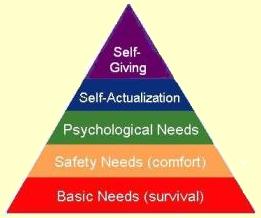
Maslow's Hierarchy of Human Needs
Adapted from The Cell
|
As a matter of principle, any strategy for the transition to clean energy must recognize integral human development as the most fundamental requirement to guide both public and private initiatives. Integral human development builds on respect for human rights and diligence on human duties, both individually and institutionally. A fundamental document is The Universal Declaration of Human Rights, approved by the United Nations General Assembly on 10 December 1948.
Hierarchy of Human Needs
Abraham Maslow (USA, 1908-1970) created the "hierarchy of human needs" in the 1940s. Maslow's model explicitly takes into account the physiological, safety, emotional, love/belonging, esteem/self-esteem, and self-actualization stages of integral human development. The hierarchy of human needs is usually represented as a pyramid, with the most basic needs at the bottom and the socialization needs at the top. There are many variations of the pyramid: one is shown to the right and others can be easily found. Going upward, the progression for each human being is to satisfy (1) the basic physical and physiological needs, (2) the need for safety and security, (3) the need psychological well-being, (4) the need for self-actualization (self-esteem, social responsibility), and (5) self-giving to others, or at least the desire to seek the common good in conjunction with legitimate self-interest. For further discussion of Maslow's "levels of human development" - and other models of human development - the reader is referred to the May 2010 issue of Mother Pelican. Attaining a culture of solidarity and sustainability is practically impossible under level 3, and generally requires level 4. This means that enabling people "to live to their full potential" requires, beyond meeting basic physical needs, access to educational and job opportunities as well as freedom for each person follow their "vocation" in life under conditions of human solidarity, social justice, and ecological sustainability. The following article, contributed by Steven Salmony, is about the feasibility of providing such opportunities in the context of current population growth trends.
UN HUMAN DEVELOPMENT REPORT 2013
|
The Rise of the South: Human Progress in a Diverse World
2013 Human Development Report, UNDP, to be launched 14 March 2013
The 2013 Human Development Report – “The Rise of the South: Human Progress in a Diverse World” – will be launched on 14 March in Mexico City by President Enrique Peña Nieto of Mexico and UNDP Administrator Helen Clark. The 2013 Human Development Report examines the profound shift in global dynamics driven by the fast-rising new powers of the developing world and its long-term implications for human development.
|
|
2. Joint Integrity of Humanity and the Human Habitat
|
Human development cannot happen in a vacuum. Therefore, maintaining the integrity of the human habitat is essential for sustainable human development. A fundamental document is The Earth Charter, approved by the Earth Charter Commission 29 June 2000 after 5 years of preparation and worldwide consultation. Since then, climate change has become the central issue of human habitat desintegration.
GLOBAL WARMING
|
Global Warming Became Reality in 2012, Seth Borenstein, Associated Press, 26 December 2012
"In 2012, many of the warnings scientists have made about global warming went from dry studies in scientific journals to real-life. Record melting of the ice in the Arctic Ocean. U.S. cities baking at 95 degrees or hotter. Widespread drought. Flooding. Storm surge inundating swaths of New York City. All of that was predicted years ago by climate scientists and all of that happened this past year. 2012 is on track to be the warmest year on record in the United States. July was the hottest month in record-keeping U.S. history, averaging 77.6 degrees. Over the year, more than 69,000 local heat records were set – including 356 locations in 34 states that hit their highest-ever temperature mark. Historic flooding in 2011 gave way to devastating drought in 2012. The drought was so extensive that nearly 2,300 counties – in almost every state – were declared agriculture disasters. At one point this summer more than 65 percent of the Lower 48 was suffering from drought. Fire season in the United States came earlier than normal and lasted longer. Nearly 9.2 million acres – an area bigger than the state of Maryland – have been burned by wildfire, the third most since accurate recordkeeping began in 1960. A bizarre summer windstorm called a derecho in the U.S. mid-Atlantic that left millions without power. Though it was never a major hurricane, Sandy stretched across nearly 1,000 miles in the U.S., bringing storm surges, power outages to millions and even snow. Sandy killed more than 125 people in the United States."
|
ETHICAL DIMENSION OF CLIMATE CHANGE
|
Climate Change and Ethics, Tim Hayward, Nature Climate Change, December 2012
"What does it matter if the climate changes? This kind of question does not admit of a scientific answer. Natural science can tell us what some of its biophysical effects are likely to be; social scientists can estimate what consequences such effects could have for human lives and livelihoods. But how should we respond? The question is, at root, about how we think we should live—and different people have myriad different ideas about this. The distinctive task of ethics is to bring some clarity and order to these ideas."
|
NATIONAL & GLOBAL CLIMATE CHANGE ASSESSMENTS
|
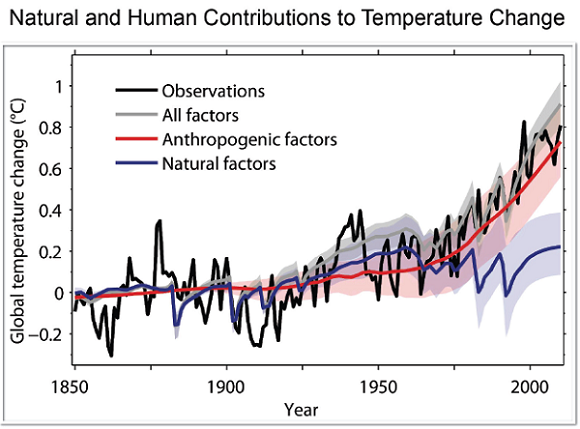
Figure 6: Natural and Human Contributions to Temperature Change
"Caption: Relative contributions to global temperature changes since 1850. Black line represents observed temperatures. Blue line indicates the modeled contribution of natural factors to global temperatures. The red line indicates the contribution of human-caused factors. The gray line represents the combined total of natural and human-caused factors. The human-caused contribution dominates the temperature increase in recent decades. (Source: adapted from Huber and Knutti, 2011)." Source of Figure 16: Anthropogenic and natural warming inferred from changes in Earth’s energy balance, Markus Huber and Reto Knutti, Nature Geoscience, 5, 31-36, 4 December 2011
|
Links to related articles:
Global Climate Change Impacts in the United States, CATO Institute, September 2012
Global Warming & Climate Change, Andrew Revkin, New York Times, 8 January 2013
Evolution of natural and social science interactions in global change research programs, Harold A. Mooney, Anantha Duraiappah, and Anne Larigauderie, PNAS, 10 January 2013 ABSTRACT FULL TEXT
SUPPLEMENT
Evolution of natural and social science interactions in global change research programs: Supporting Information, Harold A. Mooney, Anantha Duraiappah, and Anne Larigauderie, PNAS, 10 January 2013
Review of the Draft U.S. Climate Assessment Report, Judith Curry, Climate Etc., 12 January 2013
A global assessment of the effects of climate policy on the impacts of climate change, N. W. Arnell et al, Nature Climate Change, 13 January 2013
Nicholas Stern: ‘I Got It Wrong On Climate Change–It’s Far, Far Worse,’ An ‘Existential’ Threat For Many, Joe Romm, Think Progress, 28 January 2013
UNFCCC 2013-2015 Review Process, FIELD, 4 March 2013
Global Temperatures Highest in 4,000 Years, Justing Gillis, New York Time, 7 March 2013
Scientists Find an Abrupt Warm Jog After a Very Long Cooling, Andrew Revkin, New York times, 7 March 2013
The Scariest Climate Change Graph Just Got Scarier, Tim McDonnell, Mother Jones, 7 March 2013
A Reconstruction of Regional and Global Temperature for the Past 11,300 Years, Shaun Marcott et al, Science, 8 March 2013
Time for some optimism about the climate crisis, Richard Douthwaite & David Knight, Sharing for Survival, 9 March 2013
New perspectives on climate sensitivity, Judith Curry, Climate Etc., 10 March 2013
Let’s play hockey – again, Rud Istvan, Climate Etc., 11 March 2013
NOTE: The Fifth United Nations Intergovernmental Panel on Climate Change (IPCC) Report is scheduled for publication late 2013 / early 2014
|
|
3. Mitigation Strategies for Sustainable Human Development
|
There are two broad sets of strategies to ensure the long-term sustainability of the human habitat: mitigation and adaptation. As currently formulated in a globally patriarchal context, neither one assures a civilized transition from consumerism to sustainability. Such a transition becomes feasible if, and only if, there is a confluence of energy balance and gender balance. Energy balance, and a shift from fossil fuels to clean energy, is indispensable. The other indispensable catalyst is the transition from patriarchal domination to cross-gender solidarity.
Mitigation Strategies
In general, mitigation strategies attempt to minimize the risks associated with an impending threat. Ecologically, mitigation strategies attempt to reduce the rate of natural resource depletion and other negative impacts of economic activity on the human habitat. There are many kinds of mitigation strategies depending on culture, geography, the nature of the threat, vulnerability to a given threat, and the human/habitat resources to be protected from a given threat.
The following are links to online resources on mitigation strategies:
All mitigation strategies entail a tradeoff between economic growth and the ecology of the planet:
Global Coal and Natural Gas Consumption Continue to Grow, Matt Lucky & Reese Rogers, Worldwatch Institute, 31 December 2012
Excerpt: "Global consumption of coal and natural gas continued to grow in 2011. Coal use increased by 5.4 percent to 3,724.3 million tons of oil equivalent (mtoe) from the end of 2010 to the end of 2011. Demand for natural gas grew by 2.2 percent in 2011, reaching 2,905.6 mtoe. Spurred mainly by demand growth in China and India, coal’s share in the global primary energy mix reached 28 percent in 2011—its highest point since the International Energy Agency began keeping statistics in 1971. While the United States remained one of the world’s largest coal users, consumption growth in 2011 was concentrated among countries that are not part of the Organization for Economic Co-operation and Development, including China and India. Consumption in non-OECD countries grew by 8.4 percent to 2,625.7 mtoe. These countries accounted for 70.5 percent of global coal consumption in 2011. The bulk of this usage occurs in the electricity-generating sector, with smaller amounts used in steelmaking."
Cost of Combating Climate Change Surges as World Delays, Alister Doyle, Reuters, 2 January 2013
Excerpt: "An agreement by almost 200 nations to curb rising greenhouse gas emissions from 2020 will be far more costly than taking action now to tackle climate change, according to a report by the International Institute for Applied Systems Analysis in Austria. The study indicated that an immediate global price of $20 a ton on emissions of carbon dioxide would give a roughly 60 percent chance of limiting warming to below 2C. Wait until 2020 and the carbon price would have to be around $100 a ton to retain that 60 percent chance. And a delay of action until 2030 might put the 2C limit - which some of the more pessimistic scientists say is already unattainable - completely out of reach, whatever the carbon price. The report also showed that greener policies, such as more efficient public transport or better-insulated buildings, would raise the chances of meeting the 2C goal."
|
|
4. Adaptation Strategies for Sustainable Human Development
|
As already mentioned in the previous section, there are two broad sets of strategies to ensure the long-term sustainability of the human habitat: mitigation and adaptation. Most probably, attaining global energy balance will require significant adaptation of human behavior in conjunction with radical economic reforms. Such behavioral adaptation and structural reforms are contingent on gender balance and integral human development. As currently formulated in a patriarchal context, neither one assures a civilized transition from consumerism to sustainability. Such a transition becomes feasible if, and only if, there is a confluence of energy balance and gender balance. Energy balance, and a shift from fossil fuels to clean energy, is indispensable. The other indispensable catalyst is the transition from patriarchal domination to cross-gender solidarity.
Adaptation Strategies
Adaptation strategies attempt to reverse environmental degradation by changing patterns of human behavior regarding production and consumption of goods and services.
The following are links to online resources on adaptation strategies:
- Economic and Technological Transition from Fossil Fuels to Energy Balance
- United Nations - Millennium Development Goals (2015 goals in jeopardy)
- UNDP - Human Development Reports 1995-2011
- Sustainable Consumption and Production Strategies
- United Nations - National Sustainable Development Strategies
- European Union National Adaptation Strategies
- IISD National Sustainable Development Strategies
- IIED Strategies for Sustainable Development
- Hatching Capabilities for Sustainable Development in New Zealand
- The Human Dimension of Climate Adaptation
-
Technologies for Climate Change Adaptation in the Agriculture Sector
- Climate Change Adaptation in Developed Nations
- Climate Change and Industrial Policy
- IPCC - Adaptation to Climate Change in the Context of Sustainable Development and Equity
- Global Energy Governance in a Fragmented World
- Climate Change Vulnerability, Impacts and Adaptation
- UNDP - Adaptation to Climate Change in Poverty Reduction Strategies
- Planning and Preparing for Post Peak Life
- Decision Making in a Changing Climate—Adaptation Challenges and Choices
- Private Sector Engagement in Adaptation to Climate Change: Approaches to Managing Climate Risks, Shardul Agrawala et al, OECD Environment Working Papers, 30 November 2011
- Monitoring and Evaluation for Adaptation: Lessons from Development Co-operation Agencies, Nicolina Lamhauge, Elisa Lanzi, Shardul Agrawala, OECD Environment Working Papers, 28 November 2011
- Report of the Interagency Climate Change Adaptation Task Force: Federal Actions for a Climate Resilient Nation, White House Council on Environmental Quality, 28 October 2011
- The energetic society. In search of a governance philosophy for a clean economy, Maarten Hajer, PBL Netherlands Environmental Assessment Agency, 6 October 2011
- Climate Change Adaptation in Europe, European Environment Agency (EEA), March 2012.
- Gross National Happiness vs. Gross Domestic Product, Andrew Billo, Asia Society, 5 April 2012.
- Toward a Separation of Oil and State, Eric Anderson, Worldwatch Institute, 13 April 2012.
-
Adaptation Field Guide Issue, Tim Magee, CBA Climate Adaptation News, 19 April 2012.
- Coastal Land Loss and the Mitigation-Adaptation Dilemma: Between Scylla and Charybdis, Blake Hudson, Lousiana Law Review, 14 June 2012.
- World Bank Focuses on Climate Change in Hunt For Fresh Strategy, Sandrine Rastello, Bloomberg, 10 January 2013.
- Agencies Release Sustainability Plans, Include Climate Change Adaptation, Environment Reporter, Bloomberg, 8 February 2013.
Both mitigation and adaptation strategies have a role to play in attaining the transition to sustainability. But assuring the effectiveness of mitigation and adaptation strategies will require a radical upgrade in the quality of human relations, and this in turn will require a cultural transition from patriarchy to solidarity. This cultural transition has already started, but it may take a long time to run its course as it entails overcoming 5000+ years old bad mental habits. The transition from fossil fuels to clean energy may take a few decades but it is a matter of overcoming habits that are only 300 years old. Hopefully, increasingly pressing ecological issues and constraints will trigger human awareness and motivation to the point of enabling both transitions to unfold simultaneously and before it is too late. The following article is a good example of mitigation-adaptation tradeoffs:
|
"Abstract: Coastal land loss is an inevitable consequence of the confluence of three primary factors: population growth, vanishing wetlands, and rising sea levels. Society may either mitigate coastal land loss by engaging in human engineering projects that create technological solutions or restore natural processes that protect the coastal zone, or it may choose to adapt to coastal land loss by shifting development and other human and economic resources out of areas especially at risk for coastal land loss. After detailing the primary threats to coastal lands and discussing the two primary means of addressing coastal land loss - mitigation and adaptation - this article makes three normative claims for why policy-makers should approach coastal land loss mitigation in particular with caution: 1) uncertainty of mitigation’s effectiveness scientifically and institutionally; 2) the political expediency of choosing mitigation over adaptation, and 3) the fact that failure to adapt past land use activities in the coastal zone has contributed to the need to adapt or mitigate today." FREE DOWNLOAD
|
|
Excerpt: "In a new paper “Bridging the Greenhouse-Gas Emissions Gap,” for "Nature Climate Change," four researchers argue that countries and cities and companies should take 21 different energy measures that they’re already doing to reduce greenhouse gas emissions and scale them up. For example, many of the 1,000 largest greenhouse gas emitters in the world have already pledged to reduce their emissions through money-saving efficiency measures. If an organization like the World Business Council could somehow lead just 30 percent of these companies to cut their energy emissions 10 percent by 2020, that would add a significant chunk of the needed cuts. Another chunk of cuts could come from companies like Wal-Mart that have pledged to “clean up” their supply chains. Likewise, the world could get more emissions chunks if all of the hundreds of cities that have pledged to cut emissions around the world actually followed through on their promises. Another chunk could come if governments continued to pursue policies like making buildings and appliances more energy-efficient, boosting the fuel-economy of automobiles, and phasing out incandescent light bulbs. Existing initiatives to stop deforestation, clean up the shipping and aviation sectors, and eliminating fluorinated gases could add another big chunk."
|
|
Excerpt: "A major World Bank report, “Turn Down the Heat: Why a 4°C Warmer World Must be Avoided,” warns that Earth may be heading for a 7.2° Fahrenheit temperature rise by 2100 that would bring unprecedented heatwaves, droughts and floods – effects that put some of the poorest nations at highest risk. The World Bank-commissioned study notes that global temperatures have already risen 0.8°C above pre-industrial levels and will soar past the U.N. goal of limiting the increase to 2°C absent stronger policies to limit emissions. It warns that absent further commitments to curb emissions beyond existing pledges, a rise of over 3°C above pre-industrial levels is likely, and that even if nations' current pledges are implemented, there's a roughly 20 percent chance of going over 4°C by 2100."
|
|
5. Solidarity, Subsidiarity, Sustainability, and Nonviolence
|
Transitioning from consumerism to sustainability will require shifting gears in many significant ways. The following principles will be instrumental in attaining the transition to clean energy.
KEY PRINCIPLES
|
PRINCIPLE OF SOLIDARITY
"Solidarity is not a matter of altruism. Solidarity comes from the inability to tolerate the affront to our own integrity of passive or active collaboration in the oppression of others, and from the deep recognition of our most expansive self-interest. From the recognition that, like it or not, our liberation is bound up with that of every other being on the planet, and that politically, spiritually, in our heart of hearts we know anything else is unaffordable."
|
PRINCIPLE OF SUBSIDIARITY
"Subsidiarity is an organizing principle that matters ought to be handled by the smallest, lowest or least centralized competent authority... A central authority should have a subsidiary function, performing only those tasks which cannot be performed effectively at a more immediate or local level... Subsidiarity is, ideally or in principle, one of the features of federalism, where it asserts the rights of the parts over the whole."
| |
PRINCIPLE OF SUSTAINABILITY
"Sustainability is the capacity to endure. In ecology, the word describes how biological systems remain diverse and productive over time. Long-lived and healthy wetlands and forests are examples of sustainable biological systems. For humans, sustainability is the potential for long-term maintenance of well being, which has environmental, economic, and social dimensions."
|
PRINCIPLE OF NONVIOLENCE
"Nonviolence has two (closely related) meanings. (1) It can refer, first, to a general philosophy of abstention from violence because of moral or religious principle (e.g. "She believes in nonviolence.") (2) It can refer to the behaviour of people using nonviolent action (e.g. "The demonstrators maintained their nonviolence.")
|
MILLENNIUM DEVELOPMENT GOALS (MDGs)
Millennium Development Goals, United Nations.
How Population, Health and Environment Approaches Contribute to Progress on the Millennium Development Goals, BALANCED Newsletter, PHE Wilson Center, April 2012.
MILLENNIUM CONSUMPTION GOALS (MCGs)
Millennium Consumption Goals (MCGs), Proposal on Millennium Consumption Goals to the UN Rio+20 Earth Summit in June 2012,
MCG Initiative.
Primer on Millennium Consumption Goals (MCGs),
MCG Initiative, 25 July 2011.
SUSTAINABLE DEVELOPMENT GOALS (SDGs)
RIO + 20: Sustainable Development Goals (SDGs), A Proposal from the Governments of Colombia and Guatemala.
Current Ideas on Sustainable Development Goals and Indicators, UN-DESA.
A shift is needed from consumerism and the profligate use of non-renewable energy resources to quasi-exclusive use of renewable energy resources. Technologies to develop and deliver clean energy are readily available. But existing technologies, and improved ones to be developed, can make a positive contribution if, and only if, the human side of the equation (as outlined in the preceding sections) is taken care of.
SOLIDARITY, SUBSIDIARITY, AND SUSTAINABILITY IN TODAY'S WORLD

Earth lights. Photo credit: industrial-energy.lbl.gov
|
The following articles are excellent:
Looking Back on the Limits of Growth: Forty years after the release of the groundbreaking study, were the concerns about overpopulation and the environment correct?, Mark Strauss, Smithsonian Magazine, April 2012
Energy and Slavery, Guillaume Emin, EcoJesuit, 31 May 2012
America the Posssible - Part 1: From decline to rebirth,
James Gustave Speth, Orion Magazine, March/April 2012
America the Posssible - Part 2: A new politics for a new dream, James Gustave Speth, Orion Magazine, May/June 2012
A Missing Pillar? Challenges in Theorizing and Practicing Social Sustainability, Special Issue: Guest Editor Magnus Boström, SSPP, Winter 2012
Energy and Water Linkage: Challenge to a Sustainable Future, Royal Society UK, 6 June 2012
Those who govern should be required to be eco-literate, Sharon Abercrombie, NCR, 13 June 2012
New report outlines key steps to reduce poverty in a green economy, Michael Oko, Lauren Zelin, Environmental Expert, 13 June 2012
Twenty Years from Now, Gar Alperovitz, New Economics Institute, 19 July 2012
Saving Subsidiarity: Why it is not about small government, Vincent J. Miller, America Magazine, 30 July 2012
A Move Towards More Sustainable Transportation, Worldwatch Institute/Sustainable Prosperity, by Michael Replogle & Colin Hughes, August 7, 2012
Driving a Global Shift to Sustainable Transportation, Michael Replogle and Colin Hughes, CSRwire, 22 August 2012
THE SOLIDARITY-ENERGY-CLIMATE CONNECTION
Can We Survive the New Golden Age of Oil?, Steve Levine, Foreign Policy, 6 June 2012
Human-induced global ocean warming on multidecadal timescales, P. J. Gleckler et al, Nature Climate Change, 10 June 2012
Study fingers humans for ocean heat rise, Richard Chirgwin, The Register, 11 June 2012
The Battle Over Climate Science, Tom Clynes, Popular Science, 21 June 2012
Global Warming's Terrifying New Math, Bill McKibben, Rolling Stone, 19 July 2012
The Human Factor, Editorial, Nature Climate Change, 27 July 2012
Global Warming: "Humans Are Almost Entirely the Cause", Kevin Drum, Mother Jones, 29 July 2012
Our current infrastructure was built for a different planet , Kurt Cobb, Resource Insights, 29 July 2012
New Report Says Extreme Downpours Up 30 Percent; Links Trend to Global Warming, Environment America, July 31, 2012
Study Outlines Fossil Fuel Industry Opposition to Renewables, Sierra Club, August 2, 2012
New Report Follows Money Trail Behind Attacks on Clean Energy, Mary Anne Hitt, Huffington Post, 3 August 2012
Clean Energy Under Seige, Mary Anne Hitt, Sierra Club, 3 August 2012
New Study Says Extreme Heatwaves 50 to 100 Times More Likely Due to Climate Change, Ben Geman, The Hill, 5 August 2012
Rising Temperature Raising Food Prices, Earth-Policy Institute, by Lester R. Brown, August 8, 2012
July 2012 Marked the Hottest Month on Record for the Contiguous United States, National Oceanic and Atmospheric Administration, 8 August 2012
July Global Temperatures Fourth Highest on Record - Arctic Sea Ice Is Second Lowest July Extent on Record, National Oceanic and Atmospheric Administration, August 15, 2012
The RTCC Climate Change A-Z, RTCC Staff, 15 August 2012
Greenland's massive ice sheet has melted at a record-setting pace this year--and summer isn't over yet, Lauren Morello, ClimateWire, Scientific American, 16 August 2012
The Arctic Ice Crisis: Greenland’s glaciers are melting far faster than scientists expected, Bill McKibben, Rolling Stone, 16 August 2012
The Discovery of Global Warming, Spencer Weart, Scientific American, 17 August 2012
Climate Action Book 2011-2012, Climate Action/UNEP, 2012
Africa without Ice and Snow, UNEP GEAS, August 2012
A new low for global warming: Sea ice retreats to furthest point on record, Steve Connor, The Independent, 28 August 2012
The economics of oil dependence: a glass ceiling to recovery, New Economics Foundation, 10 November 2012
The Market and Mother Nature,
Thomas L. Friedman, The New York Times, 8 January 2013
|
Fossil-Fuel Subsidies of Rich Nations Five Times Climate Aid, Alex Morales, Bloomberg, 3 December 2012
"Rich countries spend five times more on fossil-fuel subsidies than on aid to help developing nations cut their emissions and protect against the effects of climate change, according to the Oil Change International campaign group. In 2011, 22 industrialized nations paid $58.7 billion in subsidies to the oil, coal and gas industries and to consumers of the fuels, compared with climate-aid flows of $11.2 billion. The subsidies enable consumers to fuel cars and heat their homes more cheaply. The International Energy Agency estimates they totaled $523 billion last year, mainly from support paid out in developing countries. Production subsidies make it cheaper for oil and gas companies to extract the fuels. Leaders of the Group of 20 nations agreed at a meeting in Pittsburgh in 2009 to phase out fossil-fuel subsidies in the "medium term."
|
|
Constructing a Transnational Climate Change Regime: Bypassing and Managing States, Kenneth W. Abbott, SSRN, 9 February 2013
"The manifest inadequacies of the inter-state negotiating processes central to international climate change policy create a pressing need for innovative modes of governance. This paper proposes one promising and feasible approach: constructing a transnational climate change regime. A transnational regime would forge stronger cross-border links among non-state actors and organizations, allowing them to address climate issues in a coordinated and collaborative manner. It would operate at multiple levels of authority and scale, enabling transnational institutions to directly engage and address intra-governmental, sub-state and societal actors within target countries. In this way the regime would bypass the governments of recalcitrant states, and of states lacking governance capacity. A transnational regime would also manage recalcitrant states by focusing advocacy, creating demonstration effects and otherwise mobilizing pressure on governments. Transnational regime entrepreneurs using a strategy of orchestration could deploy a range of incentives and other tools of influence to enroll, support and steer participating organizations, and to encourage public and private targets to accept voluntary standards and programs. The regime would complement inter-state actions where they exist, and would partially substitute for them where they do not."
|
|
UN Sustainable Energy Initiative Could Put World On a Path to Climate Targets, Science News, 24 February 2013
"The UN's Sustainable Energy for All initiative, if successful, could make a significant contribution to the efforts to limit climate change to target levels, according to a new analysis from IIASA and ETH Zurich. The study, published today in Nature Climate Change, showed that reaching the 3 energy-related objectives proposed by the United Nations in their Sustainable Energy for All (SE4All) initiative, launched in 2011, would reduce emissions of greenhouse gases that contribute to climate change and, in combination with other measures, could help keep global temperature rise from exceeding the internationally agreed target level of 2°C."
|
|
6. Non-Renewable & Renewable Energy Resources
|
Continued use and abuse of non-renewable energy sources is unsustainable. In the long-term, renewable energy sources will be indispensable. Technologies are available (or can become available with appropriate incentives) that would make it possible to meet most human energy needs with clean energy by 2050. However, to make it happen is mainly a social issue, not a technical one. Most projections on energy supply and demand reflect a "business as usal" mindset that entails continuation of recent trends. For instance, consider the data and projections (left) from the International Energy Outlook (IEO) 2011, Energy Information Administration, US Department of Energy, September 2011. For a more comprehensive set of charts, see Energy Perspectives.
Most projections to 2050 and beyond suggest that, while energy demand will continue to grow, no significant shift from fossil fuels to renewables is to be expected. Indeed, the demand for fossil fuels is very inelastic; what other choice do people have as long as there are no clean energy alternatives?. But humans are bound to be affected by continued environmental deterioration and climate change, so the extrapolation of recent growth trends into the future does not bode well for either the future health of the planet or the wellbeing of humanity. Thus is the nature of an economic system in which short-term profits are the sole arbiter of production and consumption decisions.
Lurking under the rosy projections of global energy production and consumption is the implicit assumption that economic growth - in terms of production and consumption of material commodities - will continue to grow even if population stabilizes. Any other assumption would be "politically incorrect" and therefore ruled out. However, the energy return on energy investment (EROEI, or EROI), and therefore the financial return on investment, is much higher for non-renewables than for renewables, as shown in the chart inserted to the right. As long as this is the case, the worldwide carbon-based economic and financial systems - driven as they are to minimize "time to market" and maximize short-term profits "one quarter at a time" - are utterly unable to shift priorities from carbon-based growth to sustainable stability. As economist Milton Friedman has pointed out, "only a crisis - actual or perceived - produces real change. When the crisis occurs, the actions that are taken depend upon the ideas that are lying around. That, I believe, is our basic function: to develop alternatives to existing policies, to keep them alive and available until the politically impossible becomes politically inevitable." A compilation of such alternatives, by no means exhaustive or definitively integrated, is presented in Section 7.
The Great Transition From Fossil Fuels to Renewable Energy
Lester R. Brown, Earth Policy Institute, 25 October 2012
Excerpt: "The great energy transition from fossil fuels to renewable sources of energy is under way. The old energy economy, fueled by oil, coal, and natural gas, is being replaced with an economy powered by wind, solar, and geothermal energy. As oil reserves are being depleted, the world has been turning its attention to plant-based energy sources. In 2011, the world produced 23 billion gallons of fuel ethanol and nearly 6 billion gallons of biodiesel. The growth in the use of solar cells that convert sunlight into electricity can only be described as explosive, expanding by 74 percent in 2011. The United States, for example, has under construction and development more than 100 utility scale projects. The world’s current 70,000 megawatts of photovoltaic installations can, when operating at peak power, match the output of 70 nuclear power plants. With PV installations climbing and with costs continuing to fall, cumulative PV generating capacity could surpass 1 million megawatts in 2020. (Current world electricity generating capacity from all sources is 5 million megawatts.) Many countries have enough harnessable geothermal energy to satisfy all of their electricity needs. The United States, with 130 confirmed geothermal plants under construction or in development, will be bringing at least 1,000 megawatts of generating capacity online in the near term. Worldwide, this accelerating pace could yield 200,000 megawatts of generating capacity by 2020. Each alternative energy source—whether solar, geothermal, or wind—has a major role to play, but it is wind that is on its way to becoming the foundation of the new energy economy."
|
New NREL Data Book Shows Renewable Energy on the Rise
Rachel Gelman, National Renewable Energy Laboratory (NREL), 12 November 2012
Excerpt: "NREL's new "2011 Renewable Energy Data Book" provides facts and figures on energy in general, renewable electricity in the United States, and global renewable energy development and investments. Some key findings include:
-
Renewable electricity represented nearly 13% of total installed capacity and more than 12% of total electric generation in the United States in 2011.
-
In 2011 in the United States, wind and solar photovoltaics were two of the fastest growing electric generation technologies. In 2011, cumulative installed wind capacity increased by nearly 17% and cumulative installed PV capacity grew more than 86% from the previous year.
-
Installed wind electricity capacity in the United States increased by a factor of 18 between 2000 and 2011in the same period.
-
Since 2006, the United States has been the world's leading ethanol producer. Between 2000 and 2011, U.S. production of corn ethanol increased by a factor of 8.
|
Sustainable Energy in America 2013 Factbook
Business Council for Sustainable Energy, 1 February 2013
The new report looks at clean energy broadly — from natural gas to large-scale renewables including hydropower, to distributed power, to demand-side energy efficiency. It finds:
- Renewable energy installations hit an all-time record with at least 17 GW of new nameplate capacity added in 2012.
- Policies and approaches for financing energy efficiency continued to make market headway; energy intensity for US commercial buildings has now dropped by more than 40% since 1980 and investments in smart grid topped $4 billion.
- In April 2012, electricity generation from natural gas equaled that from coal for the first time in US history.
- Carbon dioxide emissions from the energy sector were on pace to sink to their lowest level since 1994.
|
Coal Plants Are Victims of Their Own Economics
Dan Ferber, Science Magazine, 18 February 2013
"Plans for more than 150 new coal-fired power plants have been canceled since the mid-2000s, existing plants have been closed, and in 2012, just one new coal-fired power plant went online in the United States. According to a detailed analysis of coal plant finances and economics by the Institute for Energy Economics and Financial Analysis, coal is losing its battle with other power sources mostly on its merits. Over the past 6 years coal's share of U.S. electrical generation has fallen from 50% to 38%. There are several reasons for coal’s decline. Over the past decade, construction costs have risen sharply. In addition, since the mid-2000s, the price of natural gas has plummeted. Coal is also struggling because many power plants that burn it are aging to the point that more parts break and they’re becoming expensive to maintain. Sixty percent of the nation’s coal plants are more than 40 years old, and the median age of coal plants retired in 2012 was 53 years."
|
|
7. Simulation Scenarios of the Transition to Sustainability
|
This section presents the emerging synthesis of all the information in sections 1 to 7. The synthesis is presented in the form of a concept that integrates the social, economic, and energy issues that must be resolved to attain a civilized (i.e., humane) transition during the first half of the 21st century. Energy balance for entropy control is a non-negotiable requirement, and gender balance for violence mitigation is an indispensable catalyst for the transition. The strategy is presented next from the process, time-phasing, and system perspectives:
INTEGRATED TRANSITION STRATEGY - PROCESS VIEW
|
The following is a conceptual diagram of the sustainable development process:
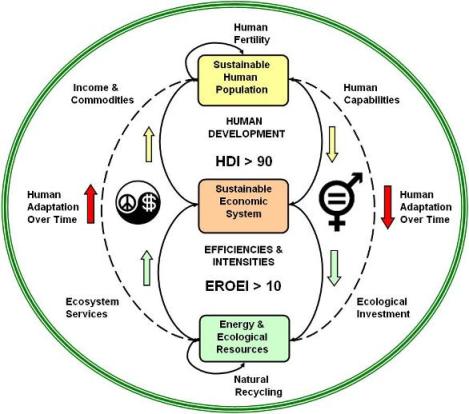
Bounded Population-Economic-Ecological System for Sustainable Human Development
Adapted from
Prosperity without Growth, Tim Jackson, 2011, Figure 12.1, Page 195
BASIC ARCHITECTURE FOR SDSIM 2.0
There are three sets of feedback loops: human development, human adaptation, and industrial mitigation. The human development loops (yellow arrows) improve gender equality and other human capabilities, and guide the allocation of income/commodities generated by the economic system. The human adaptation loops (red arrows) drive ecological investment so as to enhance the sustainability of ecosystem services. The industrial mitigation loops (green arrows) improve the productivity of energy and other resources by using "industrial engineering" methods. The working hypothesis is that mitigation loops are helpful as long as their operation is subservient to, and do not interfere with, the human development and human adaptation loops.
The convergence of gender balance, energy balance, and sustainability emerges from gender imbalance and energy imbalance jointly driving human civilization toward unsustainability. Many other factors are involved, but gender and energy imbalances are the most pervasive, and balancing them would have a neutralizing effect on all the other factors that conspire against a sustainable human society. If the transition from consumerism to sustainability is to be attained in a timely and civilized manner, i.e., before it is too late and minimizing violence as much as possible, balancing gender relations and energy flows would be the best (perhaps the only?) way to go.
INTEGRATED TRANSITION STRATEGY - PHASES VIEW
|
There are four phases: concientization, incentivation, redistribution, and democratization. Phases may overlap recursively. Time is of the esence, but the specifc start/end dates for the time windows are impossible to predict.
The following acronyms, and terminology are used in this transition concept and subsequent discussion:
Energy Return on Investment (EROI)
Energy return on Energy Investment (EROEI)
Financial Transaction Tax (FTT)
Global Citizens Movement (GCM)
Human Development (HD)
Human Development Index (HDI)
Human Development Report (HDR)
Integral Human Development (IHD)
International Standards Organization (ISO)
|
Land Value Tax (LVT) or Resource Value Tax (RVT)
Maslow's Hierarchy of Human Needs (MASLOW)
Non-Governmental Organization (NGO)
Principle of Solidarity (SOLIDARITY)
Principle of Subsidiarity (SUBSIDIARITY)
Principle of Sustainability (SUSTAINABILITY)
Sustainable Development (SD)
Sustainable Human Development (SHD)
Triple Bottom Line (TBL)
|
The formula I=PxAxT, known as "Ehrlich's Equation," is generally recognized as a good model for the ecological impact of economic activity. The impact is a nonlinear function of human population (P, # of persons), affluence (A) measured as consumption per capita ($/person), and a technology factor (T) that quantifies the impact (in physical units) per dollar of consumption. Note that for impact (I) to decrease, the technology factor (T) must go down faster than the product of population (P) and lifestyle (A) grows.
|
Several formulations are possible for IHD. The best known is the United Nations' Human Development Index (HDI) which includes three components: life expectancy, years of schooling, and GNP per capita. The are many variations of the HDI to include, for example, the gender equality dimension. Other indices attempt to replace GNP with other measures of human wellbeing, such as the Genuine Progress Indicator (GPI), the GINI Cofficient of Inequality, and the Happy Planet Index (HPI).
|
|
The transition entails maximizing human development and wellbeing as much as possible, and minimizing ecological impacts as much as possible, in a manner that leads to economic and ecological stability. Clearly, maximizing human wellbeing and minimizing ecological impact are mutually contradictory goals as long as human wellbeing is measured in terms of material consumption per capita. Since there are resource limits, and there are limits to efficiency improvements via technological innovation, something must give: humans must adapt by shifting expectations of wellbeing from economic affluence to other human development goals. It is impossible to predict how this adaptation process will unfold, but the following synopsis of the transition phases is proposed as a point of reference:
The first phase is concientization to enable incentivation. The objective is to create widespread popular support for the required revisions of tax codes and energy subsidies. In other words, the first phase is about creating a collective mindset of global citizenship and social responsibility, strong enough to translate into political will to face the inevitable transition and implement required reforms. Gender equity is key.
The second phase is incentivation to enable redistribution. The objective is to reform tax codes and energy subsidies to expedite the transition from fossil fuels to clean energy. Applicable reforms include shifting taxes from earned income to the usage (extraction) of unearned resources and the release of pollution, as well as taxing financial transactions of dubious social value. Gender equality is key.
The third phase is redistribution to enable democratization. The objective is to institutionalize democracy with gender balance and distributive justice. This may entail adopting a Universally Guaranteed Personal Income (i.e., a basic minimum income rather than a minimum wage) and a Maximum Allowable Personal Wealth (i.e., an upper limit on financial wealth accumulation) that can be democratically adjusted periodically.
The fourth phase is worldwide democratization. The objective is democratization of global, national, and local governance with deeply ingrained gender balance and widely institutionalized implementation of the solidarity, subsidiarity, and sustainability principles. Decisions are to be made at the lowest possible level consistent with governance capabilities and the common good of humanity.
The four phases are not envisioned to be strictly sequential. They most probably will overlap, with recursions and convulsions along the way. The term "gender equality" is not to be understood as "gender uniformity." By gender equality is meant equality of dignity and personal development opportunities across the entire gender continuum. In other words, full equality in all dimensions of human life: physical, intellectual, psychological, vocational, spiritual. The term "clean energy" is to be understood as "clean renewable energy" that is naturally replenished and does not produce GHG emissions when used. It does not include absurdities such as "clean coal." The combination of gender balance and energy balance is hereby proposed as the necessary and sufficient driver for a civilized (i.e., humane) transition, and are expected to have a multiplying effect throughout the global human system.
INTEGRATED TRANSITION STRATEGY - SYSTEM VIEW
|
SYSTEM VIEW OF THE SUSTAINABILITY PARADOX
The following diagram represents the present world human system:
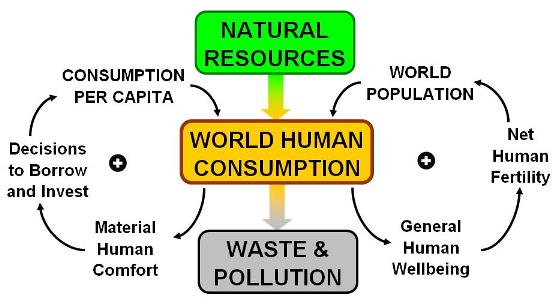
THE SUSTAINABILITY PARADOX
The positive signs indicate positive (self-reinforcing) feedback loops
Based on the Ecocosm Paradox Diagram by Willard R. Fey & Ann C. W. Lam, 1999
The downward flow at the center is the flow (lifecycle) for all kinds of merchandise. The feedback loop on the right-hand side is the population growth process. The feedback loop on the left-hand side is the economic growth process. If human consumption keeps increasing, natural resources are depleted and pollution accumulates. If human consumption decreases/stabilizes, the current economic/financial system destabilizes/collapses. This is the "infinite growth in a finite planet" paradox, which is more commonly referred to as the "sustainable development" paradox or simply the sustainability paradox.
The connecting arrows in the diagram indicate a ceteris paribus direction of influence. In the current world system the sense of every influence is positive, i.e., "more" leads to "more." However, the strength of the influence may change with time depending on various factors. For instance, the strength of the influence from "General Human Wellbeing" to "Net Human Fertility" may decrease after a certain threshold of wellbeing, higher levels of education, and accesibility to reproductive heath care. The strength of the influence from "Material Human Comfort" to "Decisions to Borrow and Invest" may increase when lines of credit with low interest rates are easy to obtain.
SYSTEM VIEW OF THE SUSTAINABILITY PARADOX
WITH SUPERIMPOSED TRENDS
The following diagram represents the present world human system with samples of recent trend data for population, consumption, and the physical flows of energy and materials:
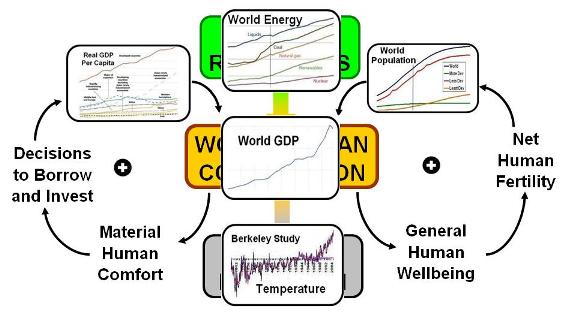
THE SUSTAINABILITY PARADOX WITH SUPERIMPOSED TRENDS
World Population 1950-2100 (UNDATA, 2010 Revision)
World Consumption Per Capita 1965-1995 (World Bank, 2011)
World Human Consumption 1960-2009 (World Bank, 2011)
World Energy Consumption 1990-2035(DOE EIA, IEO 2011)
World Average Land Surface Temperature 1800-2005 (Berkeley Earth, October 2011)
At the moment, the world's population is approximately 7 billion people but the rate of growth is slowing down. Global consumption of goods and services is approaching 60 trillion dollars, with 80% of commodities going to 20% of the population. Empirical data shows that consumption is growing faster than population, even though over one billion people remain in abject poverty. The global financial system is in total disarray. Worldwide, the rich-poor gap is increasing increasingly. Billions of tons of minerals and fossil fuels are being extracted from the earth each year, and billions of tons of waste and pollutants are being dumped back into the environment. Climate change, induced by global warming, is already impacting some human communities. Specific numbers are important, but recent growth patterns and their projected continuation are the main concern. It is impossible to predict the timing of forthcoming events, but it is reasonable to anticipate that infinite material growth in a finite planet is a mathematical impossibility.
The above hypothesis on how economic growth dynamics unfold can be refined in many different ways. For instance, the following diagram includes only the economic growth loops (left portion of the diagram) to show additional investment loops on financial credit, job creation, technology development, and advertising. Now we have a multiplicity of positive feedback loops that reinforce each other and jointly reinforce human consumption, as in the following diagram:
SYSTEM VIEW OF THE SUSTAINABILITY PARADOX
WITH MULTIPLE ECONOMIC GROWTH & JOB CREATION LOOPS
The following diagram represents the present world human system with added detail on job creation in conjunction with the economic growth process:
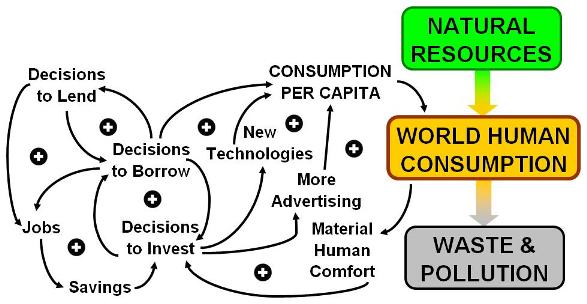
THE SUSTAINABILITY PARADOX WITH MULTIPLE ECONOMIC GROWTH & JOB CREATION LOOPS
Another way to expand the hypothesis is by including the financial growth loops whereby banks lend to industry and, in addition, lend to investors seeking financial gain for the sake of financial gain (i.e., nothing is produced or consumed). Such is the case, for example, when investor A borrows money from bank X at a given interest rate, then lends the money to investor B at a higher interest rate and pockets the additional gain. This kind of financial speculation activity (which is perfectly legal and facilitated by currencies no longer being under the gold or some other tangible resource standard) that may lead to financial bubbles and crises as happened recently in the USA and more recently in Europe. Consider the following diagram:
SYSTEM VIEW OF THE SUSTAINABILITY PARADOX
WITH MULTIPLE FINANCIAL GROWTH LOOPS
The following diagram represents the present world human system with added detail on the financial dimension of the economic growth process:
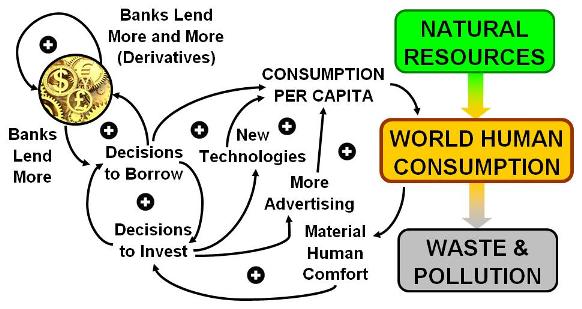
THE SUSTAINABILITY PARADOX WITH MULTIPLE FINANCIAL GROWTH LOOPS
There is empirical evidence that total world population is now increasing decreasingly, so current economic conditions suggest focusing on the economic side of the sustainability paradox. The economic growth process is driven by growing consumer demand for additional material comfort in the form of goods and services. This induces decisions to invest for expansion of industrial capacity, new technologies, and more advertising. Banks reinforce investment by lending to investors, and also by lending to consumers eager to increase their per capita consumption, which is currently growing faster than population. Since the dollar and other currencies are no longer based on gold, banks also can lend for trading in derivatives and other "financial weapons of mass destruction." This unbriddled capital accumulation process, driven by short-term profits and a systematic discounting of the future, assumes that there can be infinite growth in a finite planet, and actually requires continued and unlimited growth to keep functioning. This is the essence of the sustainability paradox.
SYSTEM VIEW OF THE SUSTAINABILITY PARADIGM
The following diagram represents the future world human system:
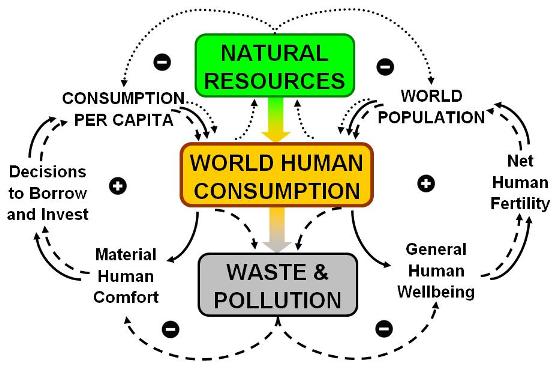
THE SUSTAINABILITY PARADIGM
The positive signs indicate positive (self-reinforcing) feedback loops
The negative signs indicate negative (self-correcting) feedback loops
The new connectors at the top linking natural resources to population and consumption per capita create adaptation loops (dotted lines). As long as natural resources are not limiting, these loops remain inactive. When one or more natural resources (e.g., minerals, water, fossil fuels) become limiting, resource prices are bound to increase and adaptation must take place by limiting population growth, economic growth, or both. On the economic side, this entails reducing consumption, substituting one resource by another, or both.
The new connectors at the bottom linking waste/pollution accumulation to human comfort (material or otherwise) are mitigation loops (dashed lines). As long as environmental degradation does not affect human comfort, these loops remain inactive. When the accumulation of pollutants is such that human well-being (material comfort, health, etc.) is impacted, the costs of environmental remediation are bound to increase and mitigation must take place by shifting priorities from comfort to survival.
SYSTEM VIEW OF THE SUSTAINABILITY PARADIGM
WITH EMBEDDED INPUT-OUTPUT MATRIX
The following diagram represents the future world human system enhanced to show the vector of resource intensities, the matrix of inter-industry transactions, and the vector of emission factors:
THE SUSTAINABILITY PARADIGM WITH EMBEDDED INPUT-OUTPUT MATRIX
The positive signs indicate positive (self-reinforcing) feedback loops
The negative signs indicate negative (self-correcting) feedback loops
Intensity factors are in resource input units per unit of merchandise produced
The input-output matrix is the Leontief matrix of interindustry transactions
Emission factors are in emission output units per unit of merchandise consumed
When the mitigation and adaptation loops are activated, analysis of possible trade-offs and substitutions will require an embedded inter-industry transactions matrix. How specificity of the analyzable trade-offs will be contingent on the granularity of industry decomposition captured by the input-output matrix. For instance, the North American Industry Classification System (NAICS) divides GDP into 24 major industry sectors which in turn are decomposed into a total of 2228 industries. The web-based Economic Input-Output Life Cycle Assessment (EIO-LCA) at the Green Design Institute, Carnegie Mellon University, divides GDP into 27 "broad sector groups," each further decomposed into a number of "detailed sectors." See also the System of National Accounts (SNA), United Nations, 2009.
SYSTEM VIEW OF THE SUSTAINABILITY PARADIGM WITH PROPOSED
RESOURCE VALUE TAXES (RVT) AND FINANCIAL TRANSACTION TAXES (FTT)
The following diagram represents the future world human system further enhanced to show self-correcting environmental and financial management loops:
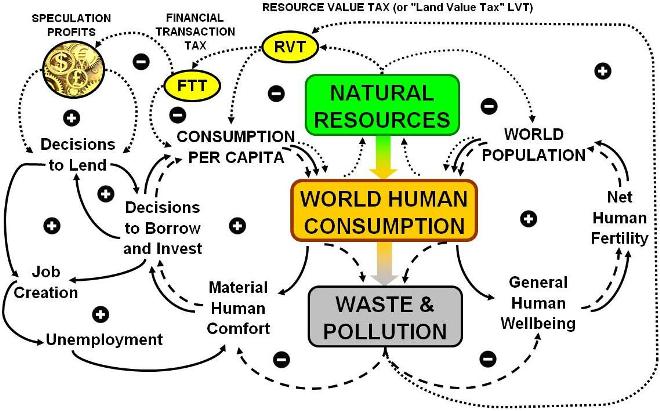
THE SUSTAINABILITY PARADIGM WITH ENVIRONMENTAL & FINANCIAL LOOPS
The positive signs indicate positive (self-reinforcing) feedback loops
The negative signs indicate negative (self-correcting) feedback loops
Resource Value Taxes (RVT) are a function of natural resource depletion/deterioration
Financial Transaction Taxes are a function of RVT and the volume of non-real financial assets
RVT and FTT serve to reinforce job creation and employment opportunities
The formulation of adaptation and mitigation policies will attempt to integrate several dimensions of scientific knowledge and human experience, including gender equality issues, in order to simulate some plausible (but by no means predictive) transition scenarios and trade-offs. For a detailed list of supporting references click here. Nothing is totally unrelated to sustainable human development, and there are many variations of any conceivable transition scenario. Some of the variations to be investigated are identified in the following section.
SDSIM 2.0 ARCHITECTURE
The architecture of SDSIM 2.0 integrates the sustainability paradox into the transition strategy:
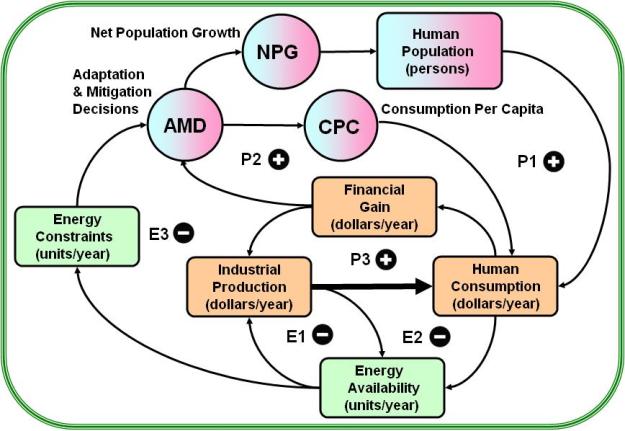
SDSIM 2.0 ARCHITECTURE (WORK IN PROGRESS)
P1, P2, and P3 are the positive population-industrial-financial loops
which currently drive the sustainable development ("infinite growth") paradox
E1, E2, and E3 are negative energy production-consumption and behavioral loops, and
AMD stands for human adaptation-mitigation decisions in response to energy availability constraints
This architecture is proposed as the simplest possible model to capture both the positive (self-reinforcing) feedback loops of the growth paradox and the negative (self-regulating) feedback loops that are bound to emerge during the transition. It is anticipated that dominance will gradually (or not so gradually) shift from the P loops to the E loops as the transition unfolds. The E loops can be generalized to include natural resources other than energy, but energy is the primary concern for SDSIM 2.0. Consideration of other resources, such as water and minerals, is planned for subsequent revisions of the architecture (SDSIM 2.1, 2.2, etc.). AMD is a function of material consumption, financial gain, and energy scarcity and serves to calculate the adaptation and mitigation decisions that are forced by economic and energy constraints. The inverse of AMD is being investigated as a possible model of social cohesion, or the collective capacity to make adaptation and mitigation decisions motivated by human development incentives as opposed to biophysical constraints.
It is critical to take explicitly into account how people and governments will behave in response to changes in the mix of financial profitability and energy availability. What function could be used to model of how people will react to changes in financial profitability and energy scarcity in a given solidarity-sustainability culture? What would be the consequences for population growth (or decline), economic growth (or decline) and quality of life during the transition from consumerism to sustainability? These are the kind of questions to be investigated (via simulation experiments) with SDSIM 2.0. It is understood that social systems are more than closed-loop feedback structures no matter how highly refined the mathematical equations and parameter values. The intent of the SDSIM project is not to provide any final answers but simply to contribute, in some small way, to define more precisely the key questions that must be answered, in a broader context of practicality and wisdom, in order to attain the transition and avoid, to the extent possible, unnecessary human suffering in the process.
SOME PRELIMINARY SIMULATIONS
The current SDSIM 2.0 is a demo, not a capability. For instance, the graph below is a simulation of world population, gross industrial production, average consumption per capita, energy availability, and social cohesion ("solidarity index") trends, during 200 years (1900-2100):
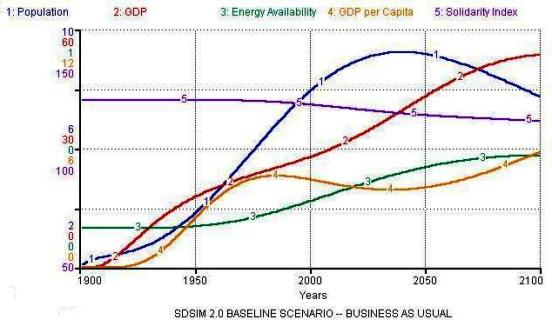
Sustainable Development Simulation (SDSIM 2.0) from 1900 to 2100
|
This simulation suggests that, toward the end of the 21st century, population and social cohesion are declining while GDP and per capita consumption are still rising even as energy availability is peaking. Is this leading to a steady-state economy at high levels of production and consumption? The next graph shows the same system simulated during 1000 years (1900-2900, as shown in the horizontal axis):
SDSIM 2.0 BASELINE SCENARIO
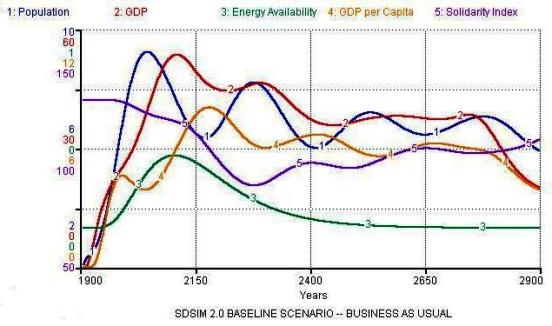
Sustainable Development Simulation (SDSIM 2.0) from 1900 to 2900
|
Due to significant time delays in adjusting population growth and resource consumption rates, and further delays in developing new technologies to "do more with less," the system goes into an extended period of oscillations in population and consumption levels. The amplitude of the oscillations seems to be gradually declining toward new steady-state levels of population and consumption, but at the expense of significant decline in social cohesion (fierce competition over increasingly scarce energy resources?). However, toward the end, drastic adjustments are induced by energy availability returning to the pre-1900 level, i.e., after a very long tail, all fossil fuel resources are finally exhausted.
Extending the simulation for another 1,000 years (next plot), the calculations suggest that another transition would be needed before long-term stability is attained:
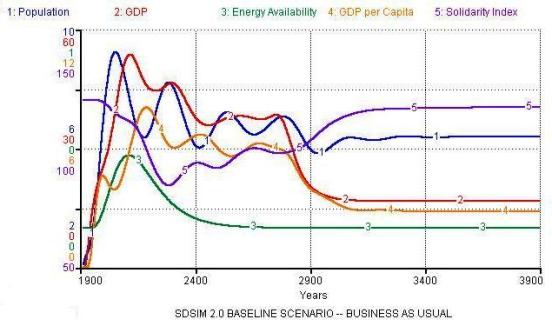
Sustainable Development Simulation (SDSIM 2.0) from 1900 to 3900
|
Beyond 2100, it would seem that the system is leading to steady-state albeit via a long series of oscillations of decreasing amplitude. However, after 2800 or so, energy availability is depleted to just above the 1900 level, or basically solar influx plus of minimum amount of energy from remaining fossil sources. Then, even if massive starvation is avoided by human adaptation, the system adjusts down to a much lower steady-state in terms of population, economic throughput, and "standard of living." Time will tell whether this will make social cohesion decline even further, or eventually induce a much higher level of solidarity (human capacity for virtue out of necessity?) as suggested by the simulation. It cannot be overemphasized that this is a simulation, not a prediction. The simulation simply shows that eventually the system must go back to an energetically sustainable steady-state.
|
SUMMARY OF BASELINE SCENARIO
This is a simulated scenario, not a prediction. It portrays dynamic modes of behavior that can be expected during the transition from consumerism to sustainability. Both simulated time (horizontal axis) and simulated variables (vertical axis) can be adjusted without changing the fundamental patterns of growth, oscillations, and degrowth. During the transition, undoubtedly there will be noise due to short-tem social, economic, and ecological perturbations, but the overall patterns of peaks and valleys will persist in the long-term, as follows:
Population peaking, then oscillating and finally decreasing to a long-term sustainable level. Note time-phasing with GDP and per capita consumption of material goods and services.
The peak in energy availability is followed by a long decline until it settles to the steady-state flow that is allowed by solar (and perhaps other cosmic) sources of energy. The "long-tail" is the result technological developments with gradually decreasing return on energy invested.
The solidarity index is currently formulated as a nonlinear function of human population, material consumption, and energy flows. It is an indicator of social cohesion, which is tightly coupled with the sustainability of resource usage. Solidarity reinforces sustainability and vice versa.
The general patterns of peaks, oscillations, and eventual settling to steady-state are indicative of turbulence during the transition, with high risk of cultural disruptions and violence. The myth of "infinite growth in a finite planet" will not be easy to overcome.
This is not intended to be an "alarmist" scenario. However, it would be wise to take the Precautionary Principle into account when formulation sustainable development policies as we enter the Anthropocene Age.
The past cannot be changed, and the future is unknown. The exact sequence and timing of events cannot be predicted, but the general transitional patterns can be anticipated on the basis of energy biophysics. Specifically, there is empirical evidence to the effect that:
1. Fossil fuel resources are high in energy content but are not infinite.
2. Fossil fuel emissions are environmentally detrimental and/or potentially unsafe.
3. Currently known clean energy alternatives offer relatively low energy content.
Given that fossil fuels are being depleted, pollution levels are damaging the environment, and clean energy alternatives may not provide enough energy to sustain industrial economies, is it wise to just continue doing "business as usual" and trusting that some earthshaking technological breakthrough will come to pass soon enough? Is it fair for people in the "developed" nations to keep indulging in energy consumption and waste while one billion people must subsist on $2 per day or less? How will population growth rate and per capita consumption change in response to impending resource constraints? Will demographic and consumption adjustments be voluntary or involuntary? If they are involuntary, there is a high risk of violence emerging in conjunction with fierce competition for resources throughout the world. Is this "the future we want"?
|
Modeling and simulating the basic variables shown above is not easy but is feasible (as forty years of Limits to Growth analysis has amply demonstrated), and it is self-evident that natural resources (energetic and otherwise) currently being used are not infinite. It is also possible to quantify other physical variables such as polluting emissions, food availability, etc. The big challenge is to formulate mitigation and adaptation decision functions (the AMD node in the architecture diagram) that could reasonably mimic some plausible ways in which human behavior might change as quality of life is impacted and resource scarcities cannot be ignored any longer. Needless to say, the intent is not to be predict but "simply" to analyze, hopefully in a way that yields some useful insight. Easier said than done, as complex financial and cultural factors will come into play.
The Human Development Index, the Environmental Performance Index, the Ecological Footprint, and other such metrics, are useful in the sense that they show the social and ecological impacts of past human decisions. However, they do not take into account how human behavior might change in response to forthcoming dynamics of the transition from consumerism to sustainability. It remains to be seen whether or not such functions can be formulated in a way that is reasonable and useful to enlighten the discussion.
|
8. Variations of the Integrated Transition Strategy
|
In terms of the transition from fossil fuels to clean energy, there seems to be a convergence of outlook that is shared by business, agencies, and NGOs. This convergence is reflected in the UN IEA and US EIA scenarios. However, in terms off replacing fossil fuels with clean energy is a post-carbon world, the Paul Chefurka's scenario is the most "pessimistic" and Stuart Staniford's scenario is the most "optimistic." Actually, it is not a matter of being optimistic or pessimistic. The divergence between "best case" and "worst case" scenarios may be due different sets of explicit
assumptions about the timing of supply peaks for non-renewables and ramping up capacities for renewables plus different sets of implicit assumptions about human behavior and policy decisions in the context of an exceedingly complex system. Energy in some form is behind everything that moves, and there are many moving parts in industrial economies.
In their recently published book,
Energy and the Wealth of Nations, Hall and Klitgaard point out that discrediting economic theories that have served us well in the past serves no purpose. It is not a matter of choosing between classical economics, or neoliberal economics, or behavioral economics, or ecological economics, or biophysical economics. But, as they also point out, it is the separation of the biophysical and social dimensions of economics that renders either one useless in confronting newly emerging issues at the intersection of human behavior and physical flows. In every case, however, energy flows are the point of intersection between the behavioral and the physical dimensions, and it could well be that "economic energetics" is the key for integrating both and developing a new synthesis, as proposed long ago by (among others) economist Nicholas Georgescu-Roegen and ecologist Howard T. Odum. In this regard, the "ecological economics" synthesis of Herman Daly deserves especial mention. Hall & Klitgaard's contribution is to isolate energy flows as the focal point for analysis (and hypothesis testing) via the "Energy Return on Investment" (EROI) index.
For the current level of climate change mitigation technologies, it would seem that Staniford's scenario is too optimistic in assuming that the production of fossil fuels can be sustained and the planet can absorb the resulting accumulation of GHG emissions without potentially catastrophic climate disruptions. On the other hand, Chefurka's scenario may be too pessimistic and hopefully will not come pass as the human-impact implications would be severe. EIA's scenario seems to be the most plausible with current technologies and economic conditions. However, the emergence of radically new and economically feasible technologies cannot be ruled out, and there is always the need to plan for the worst case scenario. With this range of scenarios in mind, the following variations are being considered for modeling and analysis:
- Variations in the desired "Quality of Life"
- Variations in the perceived value of human solidarity
- Variations in the perceived value of ecological sustainability
- Variations in the combined value of human solidarity and ecological sustainability
- Variations in the timing and duration of human adaptations
- Variations in the human propensity to consume (volume, choices, fix vs replace
- Variations in the human propensity to adapt (climate, migration, transportation)
- Variations in the pace of progress in secular gender equity, equality, and balance
- Variations in the pace of progress in religious gender equity, equality, and balance
- Variations in the adaptability of the world financial system (speculation, regulation)
- Variations in the resilience of the human habitat (pollution, climate, ecosystem services)
- Variations in fossil fuel reserves and the timing of "peak oil"
- Variations in the timing and intensity of climate changes
- Variations in the performance, schedule, and cost of clean energy technologies
- Variations in the EROI values of non-renewable and renewable energy sources
- Variations in the EROI values for resource discovery
- Variations in the EROI values for resource development
- Variations in the EROI values for resource extraction
- Variations in the EROI values for resource conversion during production
- Variations in the EROI values for resource conversion during consumption
- Variations in the EROI values for resource conversion during disposal
- Variations in the EROI values for resource emissions during production
- Variations in the EROI values for resource emissions during consumption
- Variations in the EROI values for resource emissions during disposal
Given the complexity and nonlinearity of complex ecological-economic systems, computer simulation methods are more promising for the analysis of dynamic modes of behavior related to both the "sustainability paradox" and the "sustainability paradigm" systems are diagrammed above. However, input-output analysis could be very useful to calculate specific interindustry propagations of energy resource substitutions within paradox/paradigm scenarios.
EDITOR'S NOTE: These variations are to be formulated and explored with SDSIM 2.0 (to view SDSIM 1.5, click here).
|
9. Strategic Data Sources & Global Transition Megatrends
|
Listed below are links to the best data and knowledge sources in two categories: strategic data sources and global transition megatrends.
KEY LINKS:
- STRATEGIC DATA SOURCES
- The Ecological Wealth of Nations, Global Footprint Network, 21 December 2010.
- Human Development Report, UNDP, 2011.
- Human Development Index (HDI) Database, UNDP, 2011.
- Policies and Measures Databases, UN International Energy Agency (IEA), 2011.
- Energy Research Guide and Database, US Energy Information Agency (EIA), 2011.
- Energy Outlook 2030, BP, 2011.
- Statistical Review of World Energy 2011, BP, 2011.
- 100% Renewable Energy by 2050, WWF, 2011.
- IMF Financial Databases, IMF, 2011.
- World Income Inequality Database (WIID)
- 2011 World Population Data Sheet, PRB, 2011.
- Gender, Institutions and Development Data Base (GID-DB), OECD, 2011.
- USA Federal Government Databases (DATA), US Government, 2011.
- United Nations Database (UNData), United Nations, 2011.
- International Energy Outlook 2011, US DOE/EIA, September 2011.
- World Energy Insight 2011, World Energy Council, September 2011.
- Global Megatrends Factsheet, German Advisory Council on Global Change (WBGU), October 2011.
- World Energy Outlook 2011, IEA, 9 November 2011.
- IEA sees a world run on solar, Giles Parkinson, Climate Spectator, 6 December 2011.
- Oil Market Report, IEA, 13 December 2011.
- Ireland plots path to a sustainable energy future, IEA/SEAI, 22 December 2011.
- 2012 World Population Data Sheet, Population Reference Bureau (PRB), March 2012.
- State of the World 2012: Moving Toward Sustainable Prosperity, Worldwatch Institute, April 2012.
- Vital Signs 2012: The Trends that are Shaping our Future, Worldwatch Institute, April 2012.
- Handbook on Climate Change, Human Security and Violent Conflict - Challenges for Societal Stability, Jürgen Scheffran, Michael Brzoska, Hans Günter Brauch, Peter Michael Link, Janpeter Schilling (Eds.), Hexagon Series on Human and Environmental Security and Peace, vol. 8 (Heidelberg - Dordrecht - London - New York: Springer, 30 April 2012).
- When will Oil, Natural Gas, and Coal Peak?, G. Maggio & G. Cacciola, Fuel, August 2012.
- Oil - The Next Revolution: The Unprecedented Upsurge of Oil Production Capacity and What It Means for the World, Leonardo Maugeri, Belfer Center, Harvard University, June 2012.
- Global Energy Assessment (GEA), IIASA, September 2012.
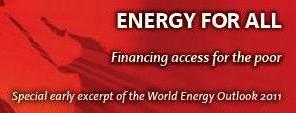
|

|
|
From the IEA WEO 2011 web site:
"The 2011 edition of the World Energy Outlook was released on 9 November and brings together the latest data, policy developments, and the experience of another year to provide robust analysis and insight into global energy markets, today and for the next 25 years. This edition of the IEA's flagship WEO publication gives the latest energy demand and supply projections for different future scenarios, broken down by country, fuel and sector.
"It also gives special focus to such topical energy sector issues as Russia’s energy prospects and their implications for global markets; the role of coal in driving economic growth in an emissions-constrained world; how high-carbon infrastructure "lock-in" is making the 2°C climate change goal more challenging and expensive to meet; the scale of fossil fuel subsidies and support for renewable energy and their impact on energy, economic and environmental trends; or the scale and type of investment needed to provide modern energy to the billions of the world’s poor that do not have it.
"WEO-2011 further analyses some of the most pressing issues faced by the energy world this year by looking at the implications of a possible delay in oil and gas sector investment in the Middle East and North Africa and also by presenting a "Low Nuclear Case" to investigate what a rapid slowdown in the use of nuclear power would mean for the global energy landscape."
|
- GLOBAL TRANSITION MEGATRENDS
-
KPGM 2012 Global Megatrends
|
Sustainable Insight: Expect the Unexpected, KPGM, 19 March 2012
In this issue of Sustainable Insight, KPMG’s network of firms analyzes a system of ten sustainability megaforces that will impact each and every business over the next 20 years.
At the same time more corporations are recognizing that there is value and opportunity in responsibility beyond the next quarter’s results; that what is good for people and the planet can also be good for the long term bottom line and shareholder value.
It is important for business leaders to understand this system of forces; assess the implications for their own organizations; and devise strategies for managing the risks and harnessing the opportunities.
We can never know the future. But it is good business sense to be prepared for the possibilities: to expect the unexpected. In this report KPMG suggests approaches to help build business value in a changing world.
Download the Expect the Unexpected Report
This summary of the full report Expect the Unexpected: Building Business Value in a Changing World report shows that population growth, exploitation of natural resources, climate change and other factors are putting the world on a development trajectory that is not sustainable. In other words, if we fail to alter our patterns of production and consumption, things will begin to go badly wrong. How wrong and for whom, is also explored in the report.
|
|
|
|Back to the SUMMARY|
|Back to SECTION 1|
|Back to SECTION 2|
|Back to SECTION 3|
|Back to SECTION 4|
|Back to SECTION 5|
|Back to SECTION 6|
|Back to SECTION 7|
|Back to SECTION 8|
|Back to SECTION 9|
Page 1
Page 2
Page 3
Page 4
Page 5
Page 6
Page 7
Page 8
Page 9
Supplement 1
Supplement 2
Supplement 3
Supplement 4
Supplement 5
Supplement 6
PelicanWeb Home Page
|
|
"If anything is sacred, the human body is sacred."
Walt Whitman – The Children of Adam (1872)
|
|
Supplement 3
|
|
FREE SUBSCRIPTION
|
![[groups_small]](groups_small.gif)
|
Subscribe to the
Mother Pelican Journal
via the Solidarity-Sustainability Group
Enter your email address:
|
|
|
|